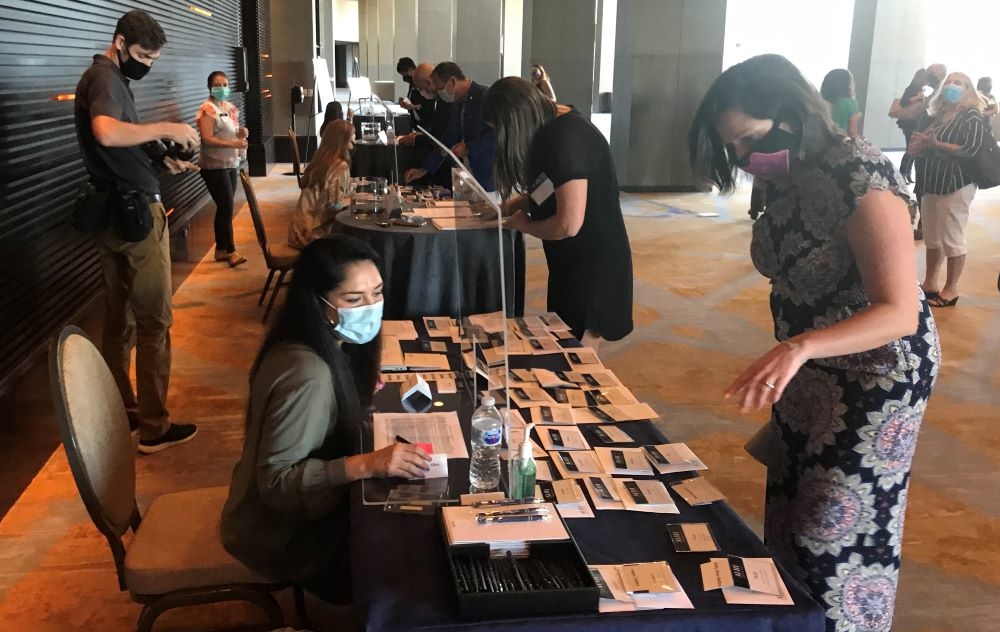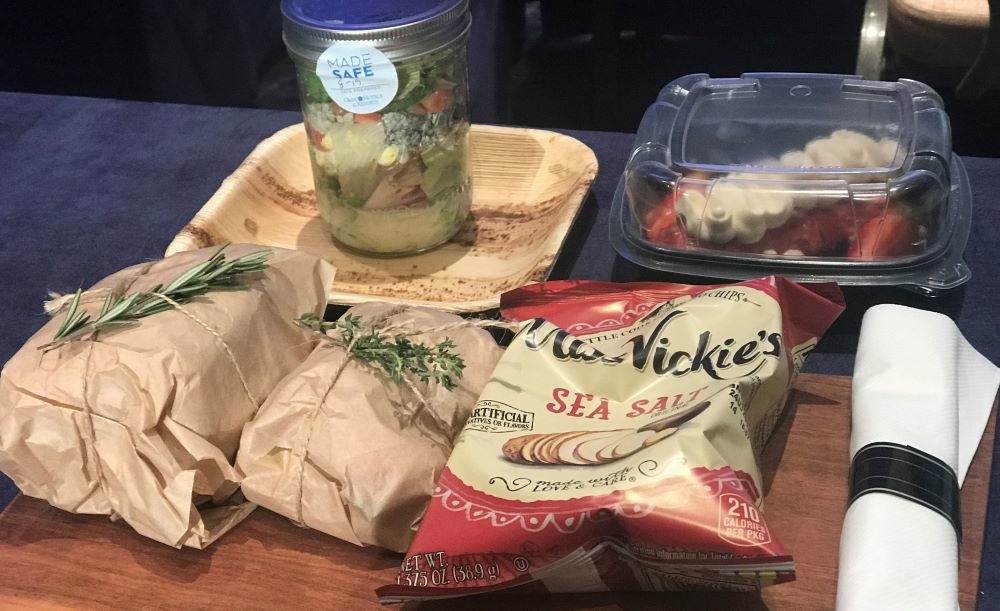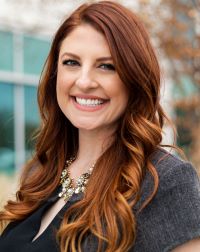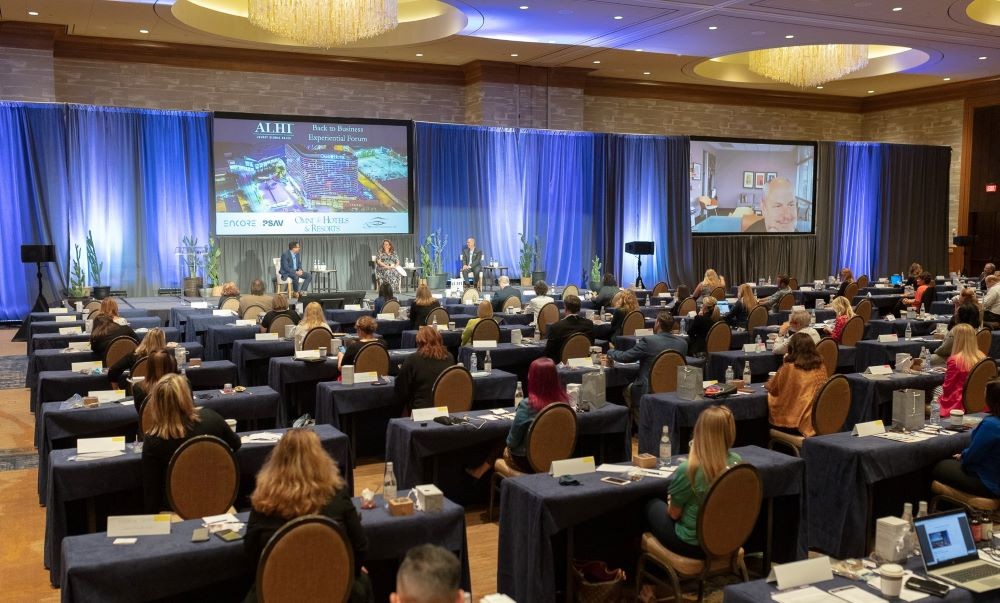After dutifully sheltering in place for nearly six months, it was safe to say that my dance card was open when Michael Dominguez, CEO of ALHI (Associated Luxury Hotels International), invited me to come to the Omni Dallas Hotel to witness the execution of the first real face-to-face meeting I’ve been to since the pre-pandemic salad days.
Like others in the meetings and events profession—planners as well as suppliers—it wasn’t enough to read about all of the sanitation and safety protocols being adopted throughout the industry. I had to see and experience it for myself, in real time, with real attendees in a real meeting venue.
People are still antsy about traveling, and my company, Stamats Communications, realizes that, telling me numerous times that I could opt not to go at any time. I figured that by taking the proper precautions, especially always wearing a mask (I even packed a shield!) and traveling with ample hand sanitizing wipes, the risk would be minimal.
Pre-Event Communication
After accepting the invitation, materials provided to me included a copy of the Event Industry Council’s Meetings and Event Code of Conduct, which the organization’s COVID-19 Business Recovery Task Force, along with other major industry organizations, drafted to educate attendees on safe practices before, during and after an event. The document can be used by any meeting or event planner to distribute to attendees prior to an in-person event.
In what may be a first in the 20 years I’ve covered meetings and events, ALHI held a conference call with participants on the Friday before the Wednesday event to detail both general details of the show as well as safety protocols.
The Journey to Dallas
Delta Air Lines would be the carrier taking me through Dallas, through Salt Lake City. I have to say I was very impressed by Delta’s commitment to safety and sanitation. The airline keeps seats adjacent to passengers empty—which it recently announced will be extended through January 6—and frequently reminded travelers of the necessity of wearing a mask at all times, along with passing out sanitary wipes and snacks that were sealed in plastic wrapping. The plane’s monitor screens also displayed frequent admonitions to wear masks, along with other safety protocols.
The Hotel Experience
Arriving at the Omni Dallas Hotel, the reality of the “New Normal” really set in. As I arrived a day early, I noticed an eerily empty house—since the hotel is adjacent to the Kay Bailey Hutchinson Convention Center and itself offers more than 100,000 square feet of meetings and convention space, it caters to the large groups who aren’t meeting at present.
Like all Omni properties, the Omni Dallas Hotel follows the chain’s Stay a Part of Safety protocols.

Although the lobby had only a few other guests, signage throughout the property’s public areas was impressive, reminding people about proper social distancing and the requirement to wear masks. Hand sanitizing stations were also present throughout the property, and check-in was conducted behind a plexiglass screen by masked staff members.
The guest room featured television remote controls that were enclosed in a plastic bag with a sticker proclaiming their sanitation, and even the room amenity was protocol friendly.
Before that evening’s welcome dinner, Omni Dallas Hotel Marketing Manager Amber Bufkin was kind enough to give me a tour of the hotel, noting that the property had just wrapped a renovation before the pandemic hit but was eager to welcome the Mecum Dallas 2020 collector car auction show October 15-17 at the adjacent Kay Bailey Hutchinson Convention Center. She also gave me a sneak peek of a meeting room that was set for proper social distancing.
Opening Dinner
A subset of what would eventually number 125-attendee meeting gathered the night before the one-day program began for an optional dinner in a hotel meeting room.
Just walking into the room and seeing banquet rounds—with only four chairs at each, to maintain social distancing—and a guitar player providing entertainment lifted my spirits. People were socializing again, and I would get a chance to break bread with meeting planner attendees I had never met before.
Just removing my mask seemed odd—almost as odd as it was to be around a bunch of people wearing them at the start of the pandemic—but since eating and mask wearing are two activities that are at odds, we all loosened up and proceeded to eat, drink and converse.
The Back to Back Experential Forum Begins
The Back to Business Experiential Forum was part educational session and part post-shutdown in-person events lab.
Registration was handled outside of the breakfast room, with attendees directed to queue up at socially distanced intervals and the registration staff operating behind plexiglass. There was a kiosk that took my temperature via standing in front of a Samsung tablet device—I passed with flying colors!—but it was not required for entrance.

After registration, attendees met for breakfast in a meeting room and shuffled to tables on each side of the room that offered packaged food items on tables, some of which were helmed by catering staff. Also in the room was safety, sanitation and signage vendor Boundless Collection, displaying their pandemic-related events products.
After breakfast, attendees entered the General Session room through a designated door, which featured individual rectangular tables for each attendee, along with sealed snacks. Attendees were instructed to write their name on a folded card so it would be “reserved” for them through the rest of the day, including lunch.
Michael Dominguez, never known to be shy in front of a crowd, took the stage and welcomed fellow panelists to discuss the current state of the meetings and events industry.
- Amada W. Hite, president of hospitality industry data company STR
- Steven Rudner, a hotel-focused attorney with Rudner Law Offices
- Ashly Balding, chief sales officer of ALHI
- Bob Priest-Heck, CEO of Freeman
- Norma Dean, director, specialty sales, Delta Air Lines
- Daniel C. Surette, chief sales officer, Omni Hotels & Resorts
Lunch Is Served
Following the opening session, attendees enjoyed a food and beverage break from individual tables with servers behind plexiglass, and then were shown three room sets that were configured to display how social distancing would look.

A working lunch found attendees returning to their individual tables, where a pre-packaged lunch of sandwiches and snacks awaited. One great takeaway food idea was a Caesar salad served in a sealed mason jar, which attendees could open up and pour onto a paper plate.
Presentations continued through the lunch, including MPI’s Jessie States previewing the virtual portion of the November 3-6 WEC Grapevine hybrid event. States also worked with Sarah Soliman Daudin, president and CEO of Soliman Productions, on the virtual component of the Back to Business Experiential Forum, which drew more than 500 viewers via streaming.
Allison Kinsley, chief meeting architect with Kinsley Meetings, and Peter Scialla, president and COO of Delos, also delivered short presentations during the lunch.
Following lunch, attendees left the general session room to gather in the breakout rooms for presentations from various ALHI property representatives.
Throughout the day, exits from the main room were accommodated in groups, with color-coded stickers on each attendee name card, in order to maintain social distancing. Think of it like tables at a wedding being called individually in order to not crowd the buffet.
The presentations ended with a flurry of socially distanced Zumba, courtesy of the Omni Dallas Hotel, which was a great way to loosen people up after a day of sitting for meetings.
[Related: ALHI CEO Dominguez on the Back to Business Experiential Forum (Podcast)]
Meeting planners in attendance shared the following feedback about the event.
“It proved to me that in-person events can still be held safely. They may look a bit different from what we’re used to, but they are still possible,” said Becki O’Connor, meeting services coordinator, Servpro Industries. “There is an energy to in-person events which can’t be replicated by a virtual event. Getting to meet new people and discuss what’s happening in the industry was wonderful. Mike [Dominguez], and all of the presenters, did a fantastic job. I loved Mike’s matter-of-fact and common-sense approach to dealing with our current circumstances.”
Becki’s co-worker, Leigh Bentley, meeting services manager for Servpro, also had positive things to say about the Back to Business Experiential Forum.
“I loved seeing the various room sets, the way the hotel handled food service, the encouragement from the event organizers to wear masks, use hand sanitizer, wash hands frequently, etc.,” she said. “I also loved the [tablet] technology set up outside of the General Session room and the dinner so we each could check our temperatures.
“I am hopeful we will be able to ‘open up’ the world and our industry safely and soon!” Bentley continued. “Hospitality, travel, etc., have been hit so hard by the response to the virus—the numbers are truly staggering. There are safe and effective ways to hold in-person events. Let’s learn from the early adopters and work to grow events in the coming months.”
Final Thoughts
In the end, I was pleasantly surprised that all of the protocols didn’t really get in the way of the traditional meeting experience too obtrusively. Just like getting used wearing a mask at the beginning of the pandemic, after a few fits and starts I adapted to social distancing and it really started to feel less awkward.
As Dominguez said, it’s all about breaking old habits, such as shaking hands or hugging people we know well. It surprised me how fast I started to adapt.
What remains to be seen is how the economics of meetings social distancing will play out. After all, hotels operate on rooms-to-space equations, and organizations that hold meetings will not have the budget to make up the difference.
But until a vaccine is developed, I discovered that the experience of meeting face-to-face is still on the table, but thorough communication, diligence and true partnership between buyers and suppliers are the essential ingredients for the success of all.
Q&A With the Lead Planner of the Back to Business Experiential Forum
 Meetings Today asked the lead planner for ALHI’s Business to Business Experiential Forum, Katie Bohrer (pictured), vice president, Meeting Design & Experience for ALHI, to describe the thought process and sanitation and social distancing protocols that led up to the event.
Meetings Today asked the lead planner for ALHI’s Business to Business Experiential Forum, Katie Bohrer (pictured), vice president, Meeting Design & Experience for ALHI, to describe the thought process and sanitation and social distancing protocols that led up to the event.
Following are Bohrer’s responses, with an eye on how they can help her fellow meeting and event planners and in-person events make a comeback.
Meetings Today: You did a kick-off call with participants detailing key aspects of the event. Do you believe this is especially critical in this post-shutdown environment, and why?
Katie Bohrer: Communication is absolutely critical. In this reimagined meeting landscape, attendees are looking to us to guide them and to share what to expect. As planners, we have always provided great communication to prepare our groups for what’s ahead.
Now, that includes preparing them for new protocols and experiences. Many of our group had not traveled since February, and want us to share what flying will be like, what hotel check-in feels like, how will we set up the room, what will food and beverage look like?
What they are really asking is, will you take care of me? Have you thought through every element of the meeting? Will I feel safe? And it’s our job to answer those questions.
It’s on the same level as sharing what the weather will be and what the dress code is. It all sets them up for success.
Additionally, I believe it creates trust between an attendee and an organization to spend the time to take any and all questions. Opening up the planning team to any concerns, or allowing people to provide fears and concerns is part of taking care of your group.
MT: What are some of the major ways planning this event is different than pre-pandemic events?
KB:
- Walking through the flow of attendees moving from event to event. How do we limit that? How do we make the groups smaller? We considered how to make movement as minimal as possible. And when we did offer breaks, we controlled traffic flow by releasing the group in pre-defined subgroups. We allowed extra break time, knowing that lines are different, and we wanted to ensure no one felt rushed.
- Adding the virtual component is truly adding another event design. We had to design both events as separate attendee experiences. While the content may be shared, the way the audience members experience the event is different. So essentially, we’re planning for two different events.
- Social distancing obviously changes the room sets and makes you consider the easiest way to present each session. We wanted to make sure that attendees had their own seat for the duration of the event, which meant we provided open seating with place cards that they wrote their name on when seated. And then in breakouts, we had the presenters rotate rooms rather than asking attendees to rotate.
- There were definitely more conversations with our partners to walk through each element and what additional protocols they would need to follow. For instance, speaking with AV to ensure that they are sanitizing all elements and where we place speakers.
MT: What specific protocols/session flow/F&B/networking event changes were done to ensure attendee safety and maintain proper social distancing?
KB:
- Specific entrance and exits.
- I mentioned breakouts and GS seats being permanent.
- We removed networking receptions.
- We explained multiple times that during all movement masks had to be worn. We reminded people of distance. Stickers on the floor at the break stations to remind them of spacing.
- F&B stations and registration desks included plexiglass shields.
MT: What key piece(s) of advice can you share with your fellow planners after learning from this process?
KB:
- Find the right partners. We know it takes a village, but especially in this environment, find partners that will be methodical and are willing to innovate with you. Find partners that have done their research and are committed to safe and healthy meetings.
- Do your homework, and regularly. We reference the WHO, CDC guidelines and leaned heavily on the EIC APEX Committee’s release of safe meeting protocols. Then, one day before our event, CDC released an updated protocol for in-person events. Our team read through every line of that document to ensure we had caught everything, and especially if they had added something.
- Be hopeful and confident that meetings are returning and that you are capable of planning a safe and healthy meeting in this reimagined meeting landscape. As planners, we have always been the best at taking care of people and creating spaces for them to learn, connect with other people, experience new things, and accomplish organizational goals. Those qualities are the same qualities that you can use to design new meeting environments with innovation, diligence and commitment to our attendees’ health and safety above all else.







